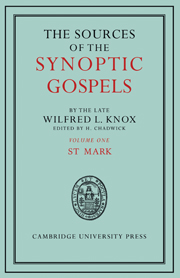Book contents
- Frontmatter
- Dedication
- Contents
- EDITOR'S PREFACE
- PREFACE
- ABBREVIATIONS
- INTRODUCTION
- I The first group of conflict-stories
- II The Twelve-source
- III Jesus and the devils
- IV The book of parables
- V Books of miracles
- VI Nazareth and John the Baptist
- VII Corban and miscellaneous incidents
- VIII A book of localized miracles
- IX The ‘Central Section’
- X The entry to Jerusalem
- XI A second group of conflict-stories?
- XII The warning against the scribes
- XIII The ‘Little Apocalypse’
- XIV The Passion story
- XV The Resurrection story
- SUMMARY
- INDEXES
IV - The book of parables
Published online by Cambridge University Press: 05 July 2014
- Frontmatter
- Dedication
- Contents
- EDITOR'S PREFACE
- PREFACE
- ABBREVIATIONS
- INTRODUCTION
- I The first group of conflict-stories
- II The Twelve-source
- III Jesus and the devils
- IV The book of parables
- V Books of miracles
- VI Nazareth and John the Baptist
- VII Corban and miscellaneous incidents
- VIII A book of localized miracles
- IX The ‘Central Section’
- X The entry to Jerusalem
- XI A second group of conflict-stories?
- XII The warning against the scribes
- XIII The ‘Little Apocalypse’
- XIV The Passion story
- XV The Resurrection story
- SUMMARY
- INDEXES
Summary
In Mark iv. 1—35 we have a source of a well-defined character. Its subject-matter and structure can still be seen, though it has been considerably modified in the course of transmission. It opens with a particular incident of Jesus preaching from a boat to the multitude; this was practically a duplicate of the typical scene which introduced the Twelve-source; Mark treats both as single incidents and covers up the fact that he is using two parallel sources by introducing the second with πάλιν. Then followed originally a triad of parables, each of which was introduced with the formal opening, ‘And he said (unto them)’. It ended with the present conclusion of 33f., which describes Jesus' habitual method of preaching; he used parables to suit himself to the capacity of his hearers and never gave them long sermons without a parable to make them more interesting. (It must be remembered that a short proverbial saying, such as 24f., is a mashal or parable; cf. Smith, The Parables of the Synoptic Gospels, pp. 31 ff.) This corresponds to the actual situation. Except in a few very rare instances, such as the Unjust Steward, where the tradition seems to have been confused, the parables in their original context would be perfectly clear to any hearer.
- Type
- Chapter
- Information
- The Sources of the Synoptic Gospels , pp. 35 - 38Publisher: Cambridge University PressPrint publication year: 2011

